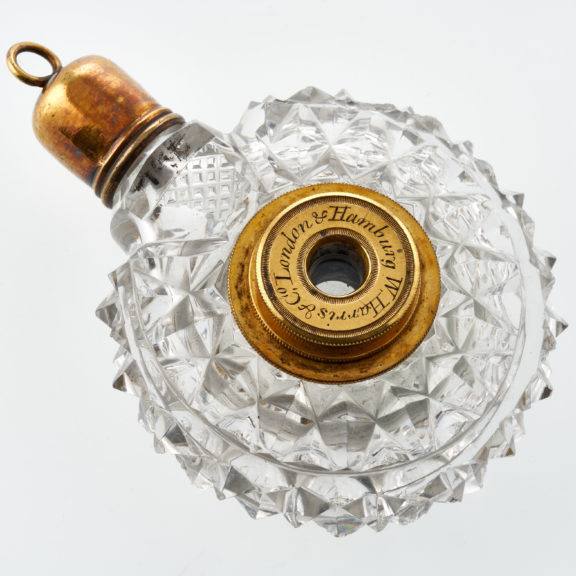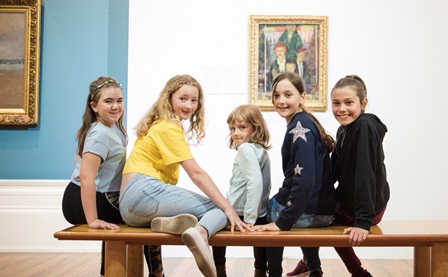Glass
The collection is dominated by two large personal collections which can be seen in the Ceramics & Glass Gallery.
The museum has an excellent glass collection with about 750 items, almost exclusively British in origin. The collection is dominated by two large personal collections which can be seen in the Ceramics & Glass Gallery.
The first is the Dr Taylor Collection, a significant selection of 1700s drinking glasses which include engraved examples and a variety of ornate stems. The second is the vibrant Mrs Seddon Collection of English Coloured Glass, which is mostly Victorian and includes tableware such as bowls, jugs and glasses.
In addition to these personal collection there is also a fun collection of novelty items – often known as ‘friggers’. These include glass boats, shoes, ties, hats, rolling pins. Contemporary pieces include an important collection of Kalim Afzal’s work, and pieces by Angela Jarman and Ana Rosa Hopkins.
Date
Around 150 items from this collection are on display. Items not on display are in our stores and are available to view by appointment.
Location
This collection is on display in the Ceramics & Glass Gallery on the 1st floor.
Cost: free
This collection is free to visit
Exploring Glass
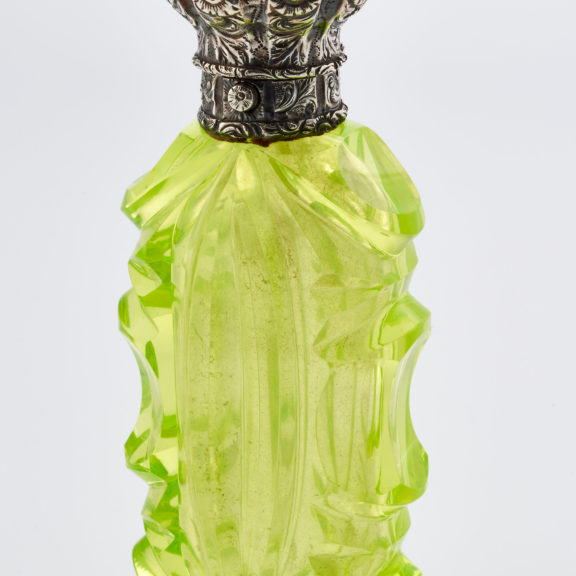
Vaseline Glass Scent Bottle
Object number: F503
This vibrant yellow/green ‘Vaseline’ glass scent bottle gets its colour from uranium oxides. If exposed to ultra-violet light it will glow in the dark! However, there is no need to panic, as there are no safety risks from this type of glass because the radiation levels are the same as those that occur naturally in our environment. Coloured glass like this developed during the nineteenth century, with Bohemia (now the Czech republic) leading the way. Lighter coloured glass like what is used in this bottle is more sensitive to light damage making it more likely for the perfume inside the bottle to go off.
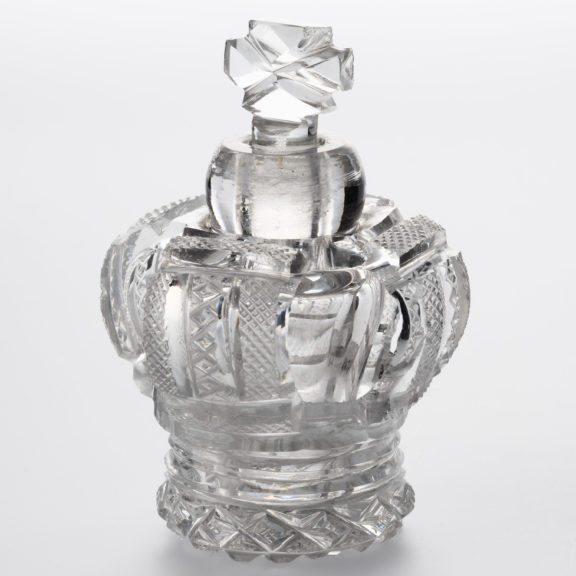
Clear Cut Glass Crown
Object number: F2476
This cut glass clear scent bottle in the shape of a crown is from the nineteenth century when the cut glass industry started to develop in Britain. Though cut glass had existed before this it had been a slow and expensive process that was made by hand, later technical developments in the steam industry meant that items could be made faster and at a reduced cost. British cut glass was of a very high quality because it used lead glass, which is harder, sharper and can be polished to a high shine. Much of the cut glass from this period actually came from Ireland, which at the time was exempt from the increased tax on the weight of glass that had been imposed on English glass-makers!
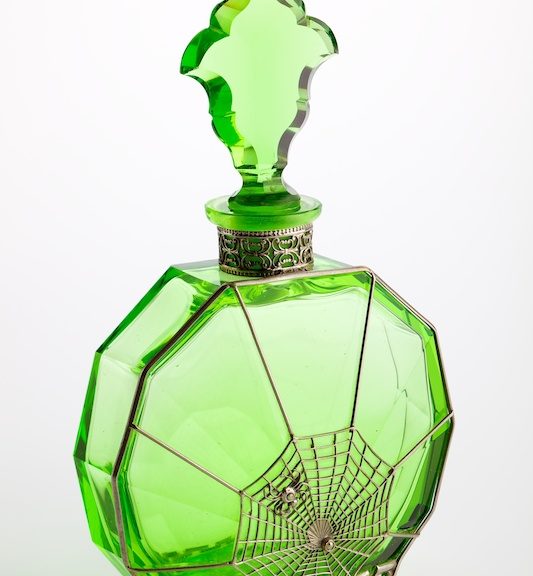
Spider’s Web Scent Bottle
Object number: F2551
This stunning green scent bottle is decorated with a spider’s web, on which a spider and its prey are picked out in marcasite. The geometric octagonal shape of the bottle and the colour combination of bright green and silver gives this piece an art deco feel. The bottle possibly was made in France and was made at a time when fewer people were buying individual bottles like this. This is because more commercial scents in their own packaging were becoming more and more fashionable.
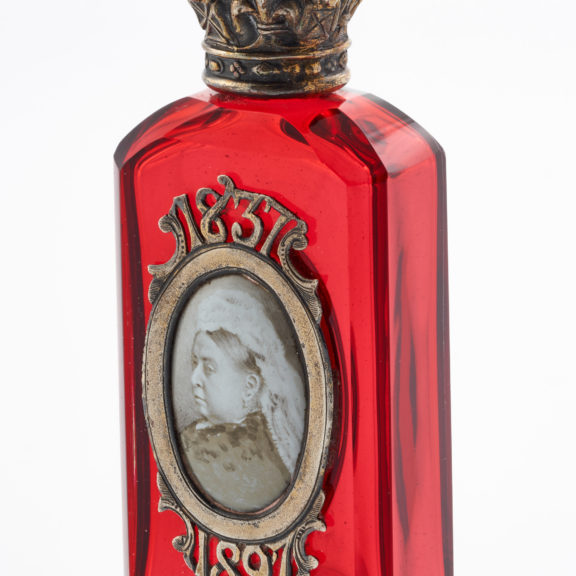
Queen Victoria Diamond Jubilee Scent Bottle
Object number: F299
This red scent bottle commemorated the Diamond Jubilee of Queen Victoria, celebrating sixty years of her being on the throne in 1897. Commemorative memorabilia like this were popular during this period. The bottle is made from red coloured glass, which developed rapidly during the nineteenth century, with Bohemia (now the Czech Republic) leading the way in coloured glass production. Glass was produced in every colour of the rainbow, thanks to modern manufacturing techniques and newly discovered pigments. Dark coloured glass, such as red, like this bottle, and blue, prolonged the life of the perfume, which could be damaged by light.
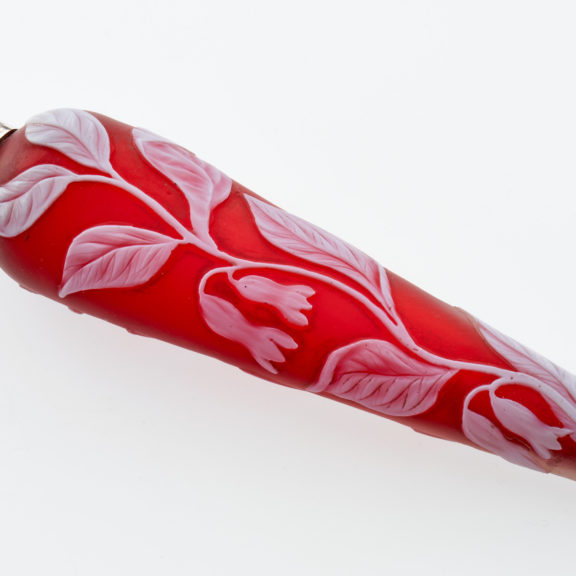
Red Cameo Glass Scent Bottle
Object number: F1673
This red scent bottle with its white leaf design is an example of cameo glass. Cameo glass is a Roman technique of producing white opaque glass designs on a darker glass background, however the technique was lost with the fall of the Roman Empire. One of the most famous pieces of roman cameo glass was the Portland vase, which was accidentally smashed in 1849. Creating cameo glass is complex as it needs more precision so a reward of £1000 was offered to the first person to make an accurate copy of it. In 1876, John Northwood, an English glassmaker made the first successful copy of the vase. During the 1880s, though expensive, the technique becoming more popular and after further technical developments it was used to create pieces like this scent bottle.
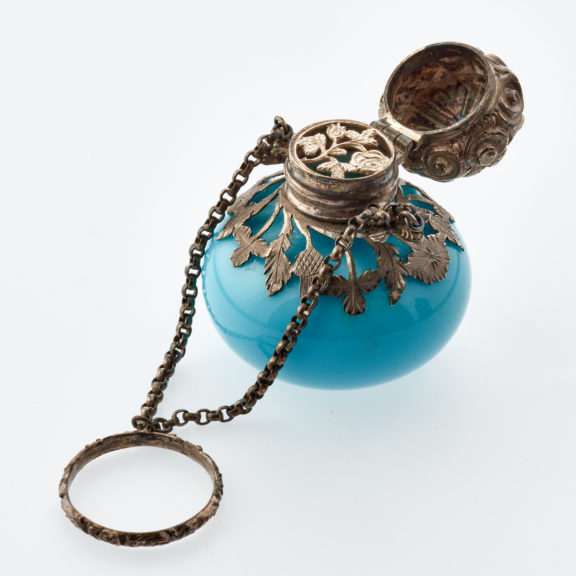
Blue Finger Ring Scent Bottle
Object number: F106
This scent bottle, made from blue coloured glass with decorative metalwork, was designed to be worn around a ladies’ finger. These bottles were often nicely decorated as they were worn at balls and for other public occasions. The bottle would be suspended from the middle finger and clutched in the palm of the hand, this would warm the perfume and mean it would emit an even stronger scent once the bottle was opened.
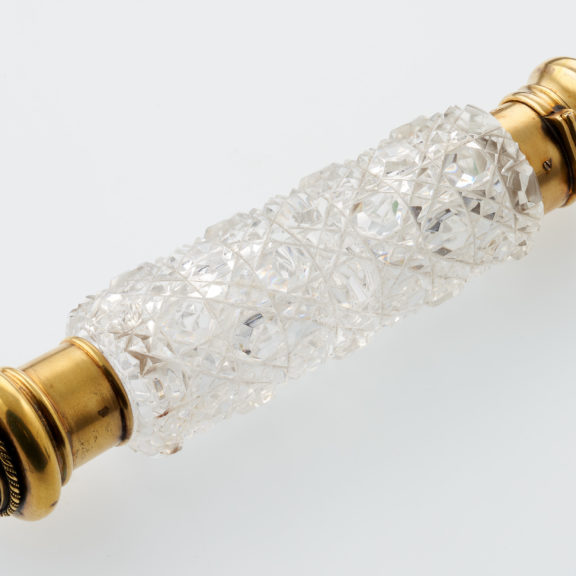
Smelling Salt Scent Bottle
Object number: F68
This is a smelling salts scent bottle made out of cut glass with decorative stone ends. These double ended bottles were made to hold perfume at one end and smelling salts or vinaigrettes at the other. Like this one the two ends usually have different types of lids, the scent end has a screw top lid over a glass ground stopper, while the smelling salt end has a hinged lid. Smelling salts, scented which rosemary, lavender, bergamot and cloves, were particularly popular in the nineteenth century. They were used to bring a lady around when she fainted, this was a common occurrence as corsets got tighter and tighter!
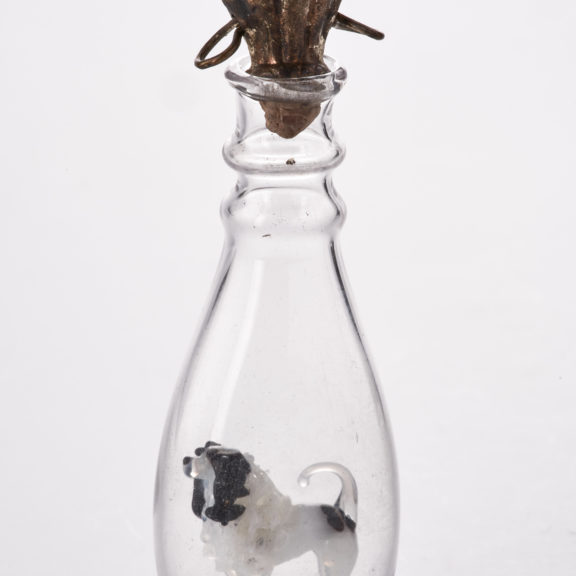
Novelty Dog Scent Bottle
Object number: F2004
This is a French novelty clear glass scent bottle containing a tiny glass dog! During the Victorian period there was a fascination with novelties and people liked perfume bottles that were made in shapes. Some of these bottles were shaped like animals, fruit, nutshells, and eggs or contained unexpected funny surprises like this little dog, which is no bigger than a small thumbnail!
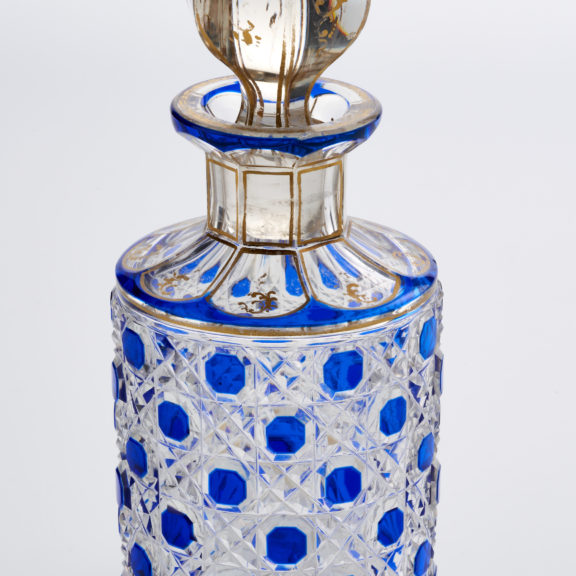
Toilet Water Bottle
Object number: F2594
This is a clear cut glass toilet water bottle with blue decoration and gold gilding. Toilet water bottles like this are generally larger than ordinary perfume bottles and were kept on the dressing table. Toilet water bottles use a dilute scent based alcohol that is cheaper to buy and lasted longer as it rarely turned rancid. It became very popular during the Victorian period because the more subtle fragrances were seen as more suitable for a lady to wear, rather than heavy perfumes. The most famous toilet water was known as cologne, which emerged at the end of the seventeenth century. In the nineteenth century lavender water became a hugely popular toilet water and is still seen as quintessentially English today.
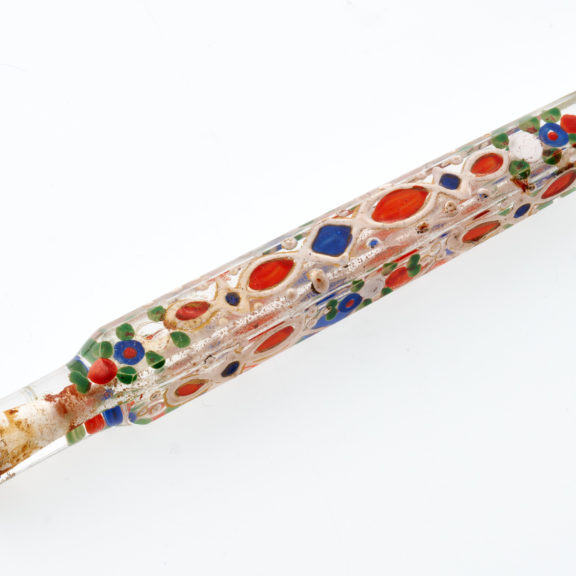
Attar Bottle
Date: Nineteenth Century
Object number: F58
This is a clear glass attar bottle decorated in red, blue, green and gold enamelling. The term attar describes an essential oil extracted by distillation. The word comes from the ancient Persian atr jul meaning ‘fat of the flowers’. Attar bottles were made in England and Bohemia (present day Czech Republic) from coloured glass, often decorated with gilding and enamelling like this one. These small bottles were bought, containing scent, over the counter from chemists and perfumers and were often thrown away once they were empty. The bottles were also known as ‘throwaways’ and ‘Oxford Lavenders’. The bottles would contain attar (or otto) of roses, which is an expensive essential oil made from rose petals so would only be bought in small amounts.
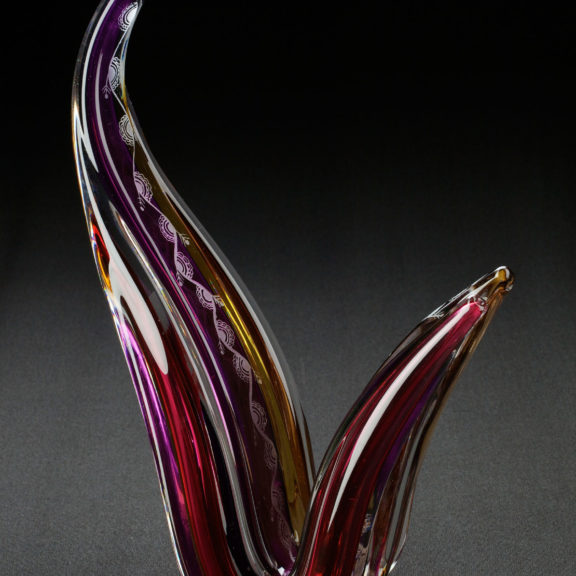
Contemporary glass piece
Date: 2002
Object number: 2004.33
Artist: Kalim Afzal
Kalim Afzal is a glass-maker based in Bradford who previously worked at the World of Glass in St Helens as Chief Designer. In 2002 Afzal had an artistic residency in Preston working with the Harris on site-specific installations for the Noor and Jamea Mosques. This piece takes fluidity and dynamism as its form and theme: it is intended to reflect Afzal’s cross-cultural identity as a British-born artist of Asian heritage. The Harris has other examples of contemporary glass practice in its collection including pieces by Angela Jarman and Ana Rosa Hopkins.
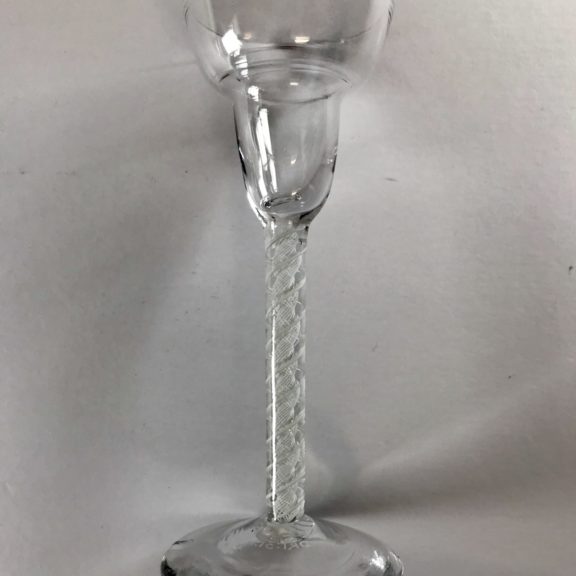
Clear wine glass
Date: 1765-85
Object number: 2006.29.22
Artist: Unknown maker
Clear wine glass, saucer topped bowl, plain stem with opaque twist and plain foot. Many of the drinking glasses at the Harris, like this one, previously belonged to, Dr Harry Taylor a local eye surgeon who lived at 13 Starkie Street in the city between 1904 and 1945.Taylor was interested in studying the changing shapes and styles of British drinking glasses during the 1700s. His collection came to the museum after his death in 1945.
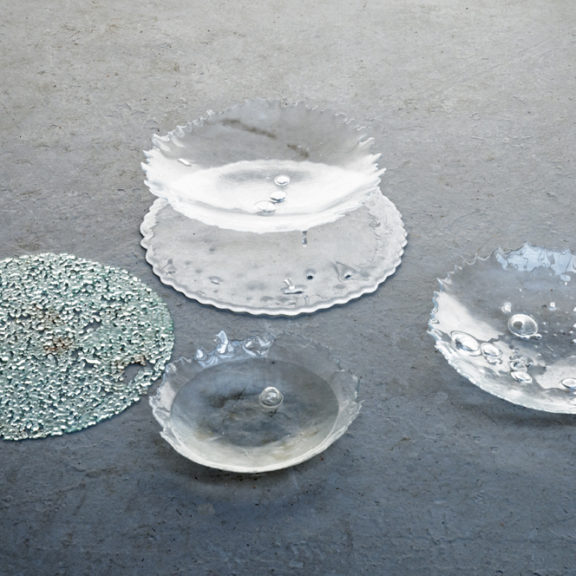
Manchester (09/08/2011)
Date: 2012
Object number: 2015.379
Artist: Ana Rosa Hopkins
This art work is made from broken glass collected by Manchester-based artist Ana Rosa Hopkins after riots in the city in August 2011. On 4 August 2011 29-year old Mark Duggan was shot by police in Tottenham, which triggered violent protests in London. Between 8 and 11 August there were riots in many other UK cities – including Birmingham, Leeds, Liverpool and Manchester. Ana Rosa Hopkins collected some of the broken glass from the Manchester riot and turned it into this art work. You can see this and other examples of historic and contemporary glasswork in the Harris collection.
Photograph: © Alan Sams
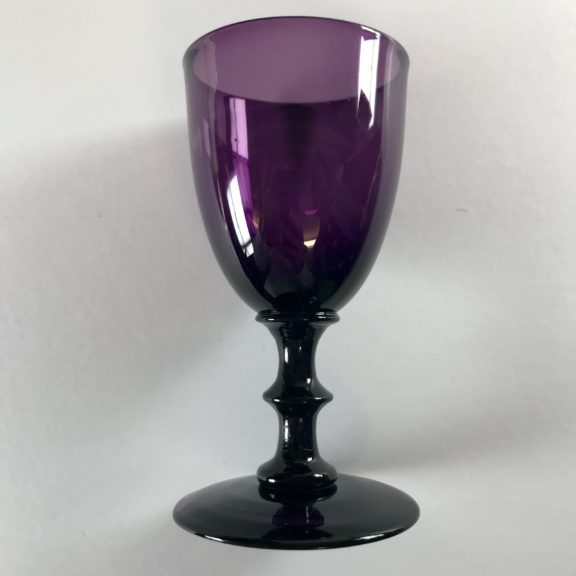
Purple wine glass with round funnel bowl
Made: Possibly Bristol or St Helens
Date: 1840
Object number: 2007.391.77
In beautiful amethyst, this wine glass is one of around 180 examples of coloured glass in the Harris collection. Most of these came from of a Manchester-based collector, Mrs Laura Seddon (1910-1995). Seddon was born in Oldham and studied mathematics at Cambridge. She was an enthusiastic collector of not just glassware – but also historic greetings cards. When her glass collection came to the Harris in 1980 she noted: ‘As a Lancastrian, I am rather pleased that a northern museum should get a collection of English glass that, as far as it goes, will be unmatched outside of London’.
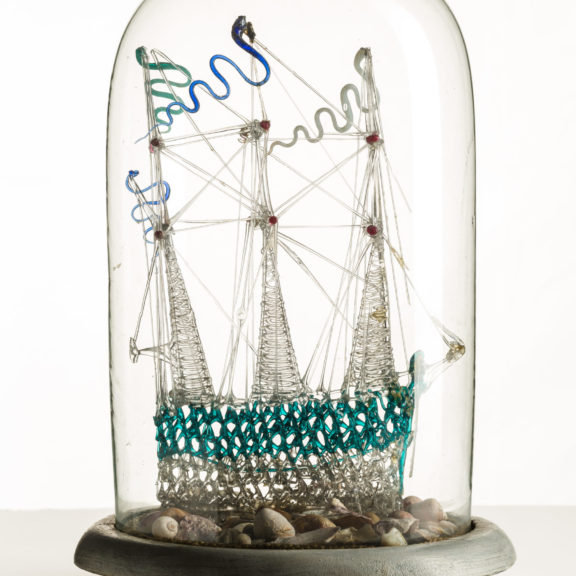
Glass Frigger
Made: Possibly Bristol or St Helens
Date: Around 1850
Object number: G209
Glass boats like this are known as friggers, or end-of-days. This sort of whimsical, funny object was made by glassmakers at the end of the working day with any molten glass left in their pot. These objects were often brought home for the glassmaker’s family. Other examples of friggers are glass boots, hats, pipes, walking sticks and even pretend pistols.
Here the glassmaker has used molten glass in its most fluid yet plastic state to build up the ship as a structure. As the glass has cooled the structure becomes fixed and solid – albeit delicately so. The sails and flags on this boat are particularly fluid and delicate.
